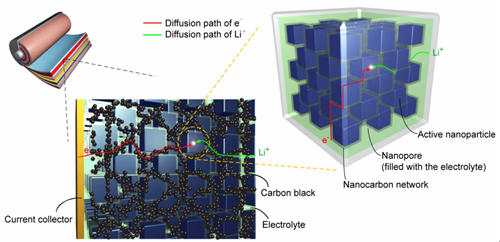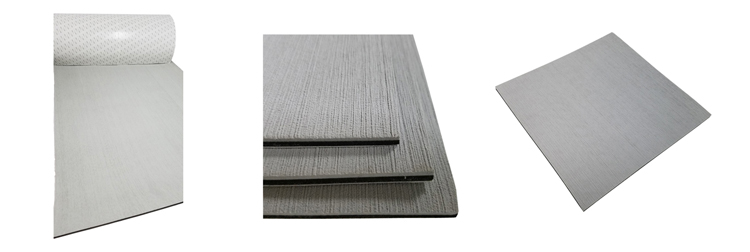In order to meet the rapid development of consumer electronics, electric vehicles, energy storage and other applications, it is urgent to further increase the energy density, power density, cycle life, and safety of lithium-ion batteries. For this reason, the development of high-performance electrode materials is the key, and it is also a research hotspot and difficulty.
With the support of the National Natural Science Foundation of China, the Ministry of Science and Technology, and the Chinese Academy of Sciences, researchers at the Key Laboratory of Molecular Nanostructures and Nanotechnology Institute of the Institute of Chemistry, Chinese Academy of Sciences, have used the “three-dimensional conductive network of nanocarbons†to design the structure of rational electrode materials, greatly improving A series of advances have been made in the electrochemical properties of various nanostructured positive and negative electrode materials (J. Am. Chem. Soc. 2012, 134, 2512; Energy. Environ. Sci. 2012, 5, 5221; Adv. Energy Mater. 2012. , 2, 1086; Chem. Commun. 2012, 48, 2198; Chem. Commun. 2012, 48, 10663; J. Mater. Chem. 2012, 22, 17456; ACS Appl. Mater. Interfaces, 2012, 4, 2824; ACS Appl. Mater. Interfaces, 2012, 4, 4858; Phys. Chem. Chem. Phys. 2012, 14, 2934). And at the invitation of the American Chemical Society's Journals of Chemical Research, he wrote a review article titled Nanocarbon Networks for Advanced Rechargeable Lithium Batteries, systematically introducing nano-carbon three-dimensional conductive network structure electrode materials in high-performance lithium ion batteries and future high specific energy Applications and development prospects of lithium metal secondary batteries (lithium-sulfur batteries, lithium-air batteries, etc.) (Acc. Chem. Res. 2012, 45, 1759).
The researchers of this research group have long devoted themselves to the research of highly efficient and stable electrode materials for high-capacity, high-rate lithium-ion batteries (Adv. Mater. 2008, 20, 2878; Adv. Mater. 2008, 20, 1160; Adv. Mater. 2009, 21,2710; Adv. Mater. 2010, 22,4591; Adv. Mater. 2011, 23, 4415; Energy. Environ. Sci., 2011, 4, 1634). Through systematic research, they found that a variety of nano-carbon structural units (carbon nano-particles, carbon nanotubes, graphene, nano-porous carbon, etc.) formed a three-dimensional conductive network with nanochannels, not only can effectively disperse the active electrode material nanoparticles, prevent Its reunion can also transport lithium ions and electrons to the surface of each active nanoparticle at a high speed, thereby realizing the dynamic advantages of the nanostructured electrode material, and developing a lithium ion battery electrode material having both high capacity and high rate performance (FIG. 1). ).
Under the guidance of this idea, researchers have made series of progresses in the use of graphene to construct electrode materials for three-dimensional conductive network structures, and developed a variety of efficient assembly methods to construct a variety of stable high-performance nanocomposite structures, anode and cathode materials. 1. They found that the use of NMP as a dispersant can be achieved through the simple blending of graphene and ternary cathode material LiNi1/3Mn1/3Co1/3O2 (LMNC) nanoparticles or organic radical polymer (PTMA) uniform composite (Figure 2 (a)), thereby significantly improving the kinetic properties of the material (Phys. Chem. Chem. Phys., 2012, 14, 2934; Energy. Environ. Sci., 2012, 5, 5221). 2. In the aspect of high-capacity alloy anodes, a method for preparing silicon nanoparticles by incorporating freeze-drying and thermal reduction methods into graphene was developed (Chem. Commun., 2012, 48, 2198). They also cleverly used the surface negatively charged nature of Si nanoparticles and graphene oxide to develop an electrostatic force layer assembly technique for the preparation of Si/graphene nanocomposite anode materials using a positively charged polymer electrolyte as a medium. Methods. Using this method, highly efficient graphene encapsulation of Si nanoparticles can be achieved, thereby greatly improving their cycle performance and rate performance (Adv. Energy Mater., 2012, 2, 1086). 3. Recently, they also proposed a dual protection design concept for high-capacity alloy anode materials (Fig. 2(b)), which combines the use of core-shell nanocarbon shells and graphene three-dimensional networks to solve the volume expansion of high-capacity electrode materials. , surface interface and dynamics issues, developed Ge@C/graphene nanostructured composite negative electrode material with excellent cycle performance and rate performance. (J. Am. Chem. Soc., 2012, 134, 2512).

Figure 1. Schematic diagram of a high-performance lithium-ion battery electrode material constructed using nanocarbon three-dimensional conductive network.

Figure 2. Graphene three-dimensional conductive network structural composite electrode material: (a) simple blending method; (b) "double protection" method; (c) layer-by-layer assembly method.
EVA Double Colors Sheet is less one production process, which is cutting the grooves than the Eva Faux Teak Sheet. This kind of Marine Sheet is for customers who own a CNC machine to cut the customized pattern based on what they need.

Through a CNC machine, you can make something beautiful more than a straight grooves. The CNC machine can help you to route a pattern, a name, a logo or whatever you like. Once it is done, then a simple peel and stick, the cut sheet can be applied on the boat decking without any more cutting.

Also we are flexible on the colors combination. It can be any color in the bottom, and it can be any color on the top. We intend to provide the best customization for different requirements from different customers.
The standard thickness would be 6mm, but we can also offer a thicker material. For example, to make a customized Helm Station Pad, the thickness should be at lease 13mm or even to 20mm, and this is what we can do for a better products service.
Eva Double Colors Sheet,Eva Marine Sheet,Eva Plastic Foam Sheet,Environmental Eva Foam Sheets,Double Color Eva Foam Sheet ,Double Colors Sheet
Huizhou Melors Plastic Products Factory , http://www.melorsfoam.com
